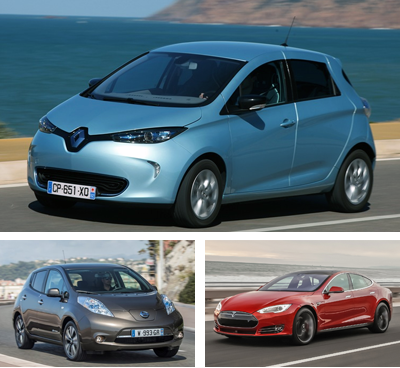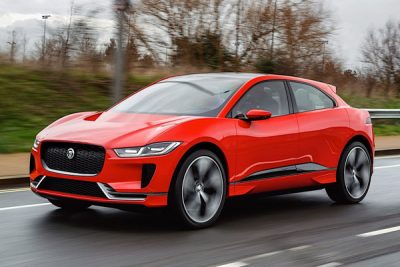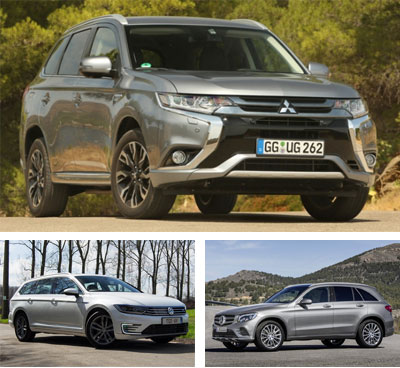 EV and PHEV sales in Europe have set another record in 2017 with a 33% increase to top 282.000 sales of plug-in vehicles, of which 132.000 full electric cars and 150.000 plug-in hybrid cars. Sales of the former surged 35% while PHEV sales spiked 31%. This means plug-in vehicles accounted for 1,8% of the European car market, up from 1,4% in 2016.
EV and PHEV sales in Europe have set another record in 2017 with a 33% increase to top 282.000 sales of plug-in vehicles, of which 132.000 full electric cars and 150.000 plug-in hybrid cars. Sales of the former surged 35% while PHEV sales spiked 31%. This means plug-in vehicles accounted for 1,8% of the European car market, up from 1,4% in 2016.
Electric cars
 The Renault Zoe sets a new record for the highest annual sales of any electric car in Europe with sales up 42% to over 30.000, giving the Zoe a 23% share of the EV segment, thanks to the updates to battery and motor which gave the Zoe a longer range in 2017. Sales of the Nissan Leaf are down 8% as the second generation of the Leaf was due in early 2018, allowing the Tesla Model S to close in for 2nd place, but it came up just short despite adding 39% to its sales. This top-3 is responsible for 47,7% of all EV sales in Europe, down from 52,4% in 2016 because of the Leaf. For 2018, the Leaf has a good chance of becoming the best selling electric car in Europe again thanks to the new model. We estimate two thirds of BMW i3 sales are without the optional range extender, as BMW doesn’t disclose exact figures. This would mean the EV version accounted for almost all of the growth of the nameplate, up 73% to 14.000 units while the PHEV remains stable at below 7.000 sales. The Volkswagen e-Golf almost doubles its sales thanks to the upgraded version, while the Tesla Model X is the 6th and last EV to sell over 10.000 units in Europe. At Hyundai, the Ioniq EV is the second most popular version of the sedan, accounting for 27,7% of the nameplate’s total, as nearly 6.300 Ioniqs are delivered without an internal combustion engine. The Kia Soul has the highest take rate of non-dedicated EVs as almost half of the Soul’s European sales was the EV version, up from a third in 2016. The new generation Smart Fortwo Electric Drive sold nearly 5.200 units in 2017, of which 1.700 in December, indicating the potential for the model in 2018.
The Renault Zoe sets a new record for the highest annual sales of any electric car in Europe with sales up 42% to over 30.000, giving the Zoe a 23% share of the EV segment, thanks to the updates to battery and motor which gave the Zoe a longer range in 2017. Sales of the Nissan Leaf are down 8% as the second generation of the Leaf was due in early 2018, allowing the Tesla Model S to close in for 2nd place, but it came up just short despite adding 39% to its sales. This top-3 is responsible for 47,7% of all EV sales in Europe, down from 52,4% in 2016 because of the Leaf. For 2018, the Leaf has a good chance of becoming the best selling electric car in Europe again thanks to the new model. We estimate two thirds of BMW i3 sales are without the optional range extender, as BMW doesn’t disclose exact figures. This would mean the EV version accounted for almost all of the growth of the nameplate, up 73% to 14.000 units while the PHEV remains stable at below 7.000 sales. The Volkswagen e-Golf almost doubles its sales thanks to the upgraded version, while the Tesla Model X is the 6th and last EV to sell over 10.000 units in Europe. At Hyundai, the Ioniq EV is the second most popular version of the sedan, accounting for 27,7% of the nameplate’s total, as nearly 6.300 Ioniqs are delivered without an internal combustion engine. The Kia Soul has the highest take rate of non-dedicated EVs as almost half of the Soul’s European sales was the EV version, up from a third in 2016. The new generation Smart Fortwo Electric Drive sold nearly 5.200 units in 2017, of which 1.700 in December, indicating the potential for the model in 2018.
We’ve written about the Opel Ampera-e in the small MPV segment analysis, saying “Opel desperately needed this car under General Motors as it was way behind in engine technology due to underinvestment, leading to above average fuel consumption and CO2 emissions, on which it would have to pay huge fines. The Ampera-e would lower its average fleet fuel consumption and save the company millions in fines, so much that it was prepared to sell the Ampera-e at a loss per unit. With PSA as the new owner of Opel, the brand has now access to the engine technology of the French which will allow it to reduce its fuel consumption with every model that is developed onto a PSA platform, much quicker and cheaper than it could have done by itself, reducing the need for high, loss-making, volume of the Ampera-e. Since PSA buys this car from General Motors it has no incentive to sell it at a loss, and as a result it has raised prices as soon as the takeover was a done deal. That greatly reduces the Ampera-e’s chances of success in Europe.” It sold just 1.918 units in Europe, compared to 23.000 as the Chevrolet Bolt in the US.
 In 2018 we can expect a number of new and updated models, of which the most promising are the new Nissan Leaf and the Hyundai Kona EV/Kia Niro EV duo. The first few deliveries of the Tesla Model 3 may take place depending on how quickly production can ramp up, but expect the company to prioritize US deliveries over Europe. The Jaguar I-Pace is a model to look out for as well. Furthermore, Audi will launch the e-Tron Quattro SUV and Mercedes-Benz is launching its EQ subbrand with the EQC but both may not be ready for customer deliveries until 2019. The Porsche Mission E sedan is expected to hit showroom this year and will be the first true challenger for Tesla. Smart will also electrify the Forfour, Hyundai will replace the ix35 FCEV with the Nexa Fuel Cell vehicle but considering the limited fuel stations for this technology it will remain a niche player in Europe.
In 2018 we can expect a number of new and updated models, of which the most promising are the new Nissan Leaf and the Hyundai Kona EV/Kia Niro EV duo. The first few deliveries of the Tesla Model 3 may take place depending on how quickly production can ramp up, but expect the company to prioritize US deliveries over Europe. The Jaguar I-Pace is a model to look out for as well. Furthermore, Audi will launch the e-Tron Quattro SUV and Mercedes-Benz is launching its EQ subbrand with the EQC but both may not be ready for customer deliveries until 2019. The Porsche Mission E sedan is expected to hit showroom this year and will be the first true challenger for Tesla. Smart will also electrify the Forfour, Hyundai will replace the ix35 FCEV with the Nexa Fuel Cell vehicle but considering the limited fuel stations for this technology it will remain a niche player in Europe.
2017 EV sales Europe
| Electric Car Segment | 2017 | 2016 | Change | %EV 2017 | %EV 2016 | |
| 1 | Renault Zoe | 30.134 | 21.240 | 42% | 100% | 100% |
| 2 | Nissan Leaf | 16.832 | 18.210 | -8% | 100% | 100% |
| 3 | Tesla Model S | 16.026 | 11.564 | 39% | 100% | 100% |
| 4 | BMW i3 (est.) | 14.076 | 8.125 | 73% | 67% | 54% |
| 5 | Volkswagen e-Golf | 12.895 | 6.657 | 94% | 2,7% | 1,4% |
| 6 | Tesla Model X | 11.877 | 3.683 | 222% | 100% | 100% |
| 7 | Hyundai Ioniq EV | 6.292 | 0 | New | 27,7% | – |
| 8 | Kia Soul EV | 5.551 | 4.417 | 26% | 44,6% | 32,5% |
| 9 | Smart Fortwo Electric Drive | 5.191 | 0 | New | 7,9% | – |
| 10 | Volkswagen e-Up! | 3.056 | 2.557 | 20% | 3% | 2,6% |
| 11 | Opel Ampera-e | 1.918 | 0 | New | 100% | – |
| 12 | Peugeot iOn | 1.544 | 1.881 | -18% | 100% | 100% |
| 13 | Citroën C-Zero | 1.105 | 1.780 | -38% | 100% | 100% |
| 14 | Mitsubishi i-MiEV | 447 | 484 | -8% | 100% | 100% |
| 15 | Citroën E-Mehari | 353 | 569 | -38% | 100% | 100% |
| 16 | Hyundai ix35 FCEV | 160 | 106 | 51% | 0% | 0% |
| Segment total | 132.010 | 97.426 | 35% |
Plug-in Hybrid electric cars

PHEV sales increase 31% in 2017 after a 17% gain in 2016, and while Mitsubishi has the best selling nameplate in its stable, BMW is the best selling Plug-in hybrid brand with nearly 41.000 sales of its 6 models, accounting for 26,6% of the PHEV sales in Europe. Its best seller is the 225xe Active Tourer with a take rate of 12,7%. The Mitsubishi Outlander holds on to its top spot despite losing 10% of its volume. Its take rate of 52,9% for the PHEV version is stable on 2016 and the highest in the industry. The Volkswagen Passat GTE grows just 4% but because the gasoline and diesel versions are down, the plug-in version increases its take rate to 7,4%.  In third place we find another crossover, the Mercedes-Benz GLC350e with a take rate of 10%. It will be interesting to see how the upcoming Volvo XC60 PHEV will compete against it. The BMW 330e is not far behind as the second best selling plug-in vehicle for the brand, ahead of the i3 REx for which the (estimated) take rate declined after the range of the EV was improved, keeping sales of this version stable. A similar effect happened with the Volkswagen Golf GTE which sold fewer units than in 2016 and was outsolf by the e-Golf thanks to that model’s improved range. The GTE’s sibling Audi A3 e-Tron did manage to improve and increases its take rate to 5,1%. Sales of the Volvo XC90 T8 are down but the take rate of the Twin Engine version remains almost stable at nearly 26%, much higher than its rival BMW X5 40e. Porsche claims the Panamera the plug-in hybrid has accounted for 60% of the model’s sales since the launch of the option in June, leading to a 40,6% take rate for the year so far. Like with the i3 and the Golf, at Hyundai the PHEV is also the least popular version of the Ioniq with just 8,4% of the model’s sales. This could lead to the conclusions that PHEVs are obsolete when comparable EVs have a long enough range. This makes sense as it is far more expensive to equip a car with both an ICE and an electric motor and batteries, including in maintenance. So as soon as EVs have enough range to reduce range anxiety, PHEVs will be abandoned.
In third place we find another crossover, the Mercedes-Benz GLC350e with a take rate of 10%. It will be interesting to see how the upcoming Volvo XC60 PHEV will compete against it. The BMW 330e is not far behind as the second best selling plug-in vehicle for the brand, ahead of the i3 REx for which the (estimated) take rate declined after the range of the EV was improved, keeping sales of this version stable. A similar effect happened with the Volkswagen Golf GTE which sold fewer units than in 2016 and was outsolf by the e-Golf thanks to that model’s improved range. The GTE’s sibling Audi A3 e-Tron did manage to improve and increases its take rate to 5,1%. Sales of the Volvo XC90 T8 are down but the take rate of the Twin Engine version remains almost stable at nearly 26%, much higher than its rival BMW X5 40e. Porsche claims the Panamera the plug-in hybrid has accounted for 60% of the model’s sales since the launch of the option in June, leading to a 40,6% take rate for the year so far. Like with the i3 and the Golf, at Hyundai the PHEV is also the least popular version of the Ioniq with just 8,4% of the model’s sales. This could lead to the conclusions that PHEVs are obsolete when comparable EVs have a long enough range. This makes sense as it is far more expensive to equip a car with both an ICE and an electric motor and batteries, including in maintenance. So as soon as EVs have enough range to reduce range anxiety, PHEVs will be abandoned.
2017 PHEV sales Europe
| PHEV segment | 2017 | 2016 | Change | % PHEV 2017 | % PHEV 2016 | |
| 1 | Mitsubishi Outlander PHEV | 19.189 | 21.318 | -10% | 52,9% | 52,5% |
| 2 | Volkswagen Passat GTE | 13.599 | 13.110 | 4% | 7,4% | 6,3% |
| 3 | Mercedes-Benz GLC350e | 11.249 | 1.865 | 503% | 10,1% | 2,7% |
| 4 | BMW 225xe Active Tourer | 10.805 | 5.915 | 83% | 12,7% | 5,9% |
| 5 | BMW 330e | 10.117 | 8.691 | 16% | 7,8% | 6,0% |
| 6 | Volkswagen Golf GTE | 9.267 | 11.329 | -18% | 1,9% | 2,3% |
| 7 | Audi A3 e-Tron | 8.356 | 6.908 | 21% | 5,1% | 3,6% |
| 8 | Volvo XC90 T8 Twin Engine | 7.847 | 9.469 | -17% | 25,8% | 26,7% |
| 9 | BMW i3 REx (est.) | 6.934 | 6.874 | 1% | 33% | 46% |
| 10 | Mercedes-Benz C350e | 6.861 | 10.125 | -32% | 3,9% | 5,8% |
| 11 | BMW 530e | 6.143 | 0 | New | 5,6% | – |
| 12 | BMW X5 40e | 5.944 | 5.309 | 12% | 17,2% | 14,3% |
| 13 | Porsche Panamera PHEV (est.) | 4.251 | 0 | New | 40,6% | – |
| 14 | Hyundai Ioniq PHEV | 1.900 | 0 | New | 8,4% | – |
| 15 | BMW i8 | 988 | 1.517 | -35% | 100% | 100% |
| Segment total | 150.133 | 114.907 | 31% |
Click on any model to see its annual sales from 1997-2016 and monthly sales in 2012 to 2016, or use the dropdown menu in the top right of this site.
Car sales statistics are from the following countries: Austria, Belgium, Cyprus, Czech Republic, Denmark, Estonia, Finland, France, Germany, Great Britain, Greece, Hungary, Iceland, Ireland, Italy, Latvia, Lithuania, Luxembourg, Netherlands, Norway, Poland, Portugal, Romania, Slovakia, Slovenia, Spain, Sweden, Switzerland.
Sources: Manufacturers, ANDC, JATO Dynamics.


